This is “Keywords and Match Types”, section 7.3 from the book Online Marketing Essentials (v. 1.0). For details on it (including licensing), click here.
For more information on the source of this book, or why it is available for free, please see the project's home page. You can browse or download additional books there. To download a .zip file containing this book to use offline, simply click here.
7.3 Keywords and Match Types
Learning Objectives
- Become familiar with match types.
- Learn why match types are important to PPC (pay per click).
We’ll take a look at keyword selection when we go through the process of setting up a campaign, but first you need to know a little bit more about the different ways we can define keywords in a PPC (pay-per-click) campaign.
Each search engine requires the advertiser to enter the keywords for which their advertisement should appear. This list of keywords determines the search queries for which the advertisements could appear.
On http://www.google.com in the United States, there were approximately 235 million searches performed each day,Wendy Tanaka, “Google Hits Double Digits,” Forbes, September 5, 2008, http://www.forbes.com/2008/09/04/google-tenth-anniversary-tech-enterprise-cx_wt_0905google.html (accessed June 18, 2010). and Google estimates that nearly 50 percent of all searches are unique.Patricia Hursh, “Marketing in the Search Tail: Is the Pain Worth the Gain?” Search Engine Watch, January 24, 2006, http://searchenginewatch.com/3579396 (accessed June 18, 2010). It would be a tough, if not impossible, task to determine all the possible terms potential customers might use to find you. That is why there are different keyword match types for PPC advertising.
Google AdWords uses the following match types:
- Broad matchYour ad will appear for the keywords you have entered, terms that contain your keywords and any other words in any order, and some variations.
- Phrase matchYour ad will appear only for search terms that have your keywords in them, in the same order, though other words may also be in the search term.
- Exact matchThe ad will only appear for search terms exactly the same as the keywords selected.
- Negative matchYour ad will not appear in searches using that word, no matter what other words are used.
Figure 7.4
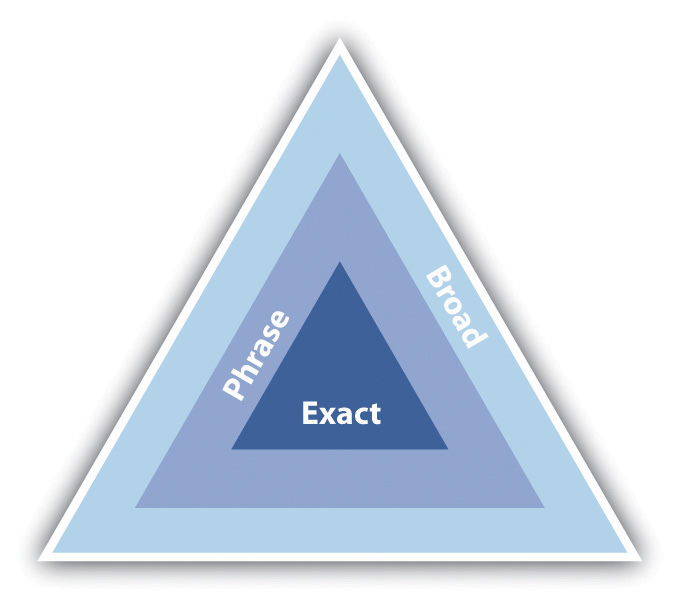
Depending on the match type, your advertisement can appear for more or fewer keywords.
Broad match means that your advertisement will appear for the keywords you have entered, as well as search termsAnother way of saying search query. that contain your keywords and any other words in any order, as well as some variations of your keywords (misspellings and synonyms).
Say you have chosen the following keywords, and this is set to broad match:
- tennis shoes
Your advertisement could appear for all the following searches:
- tennis shoes
- red tennis shoes
- tennis sneaker
- history of tennis shoes
Phrase match, which is denoted with quotation marks around the keywords (“phrase match”) means that your advertisement will appear only for search terms that have your keywords in them, in the same order, though other words may also be in the search term.
If you changed the same keywords to phrase match, they would look like the following:
- “tennis shoes”
Your advertisement would appear for the following:
- tennis shoes
- tennis shoes red
But your advertisement would not appear for the following:
- smart shoes red
Exact match, denoted by square brackets ([exact match]), means that the advertisement will only appear for search terms exactly the same as the keywords selected.
Now change the keyword to exact match:
- [tennis shoes]
Your advertisement will appear for searches for the following:
- tennis shoes
It would not appear for any other searches.
Figure 7.5 Match Types for Certain Search Terms
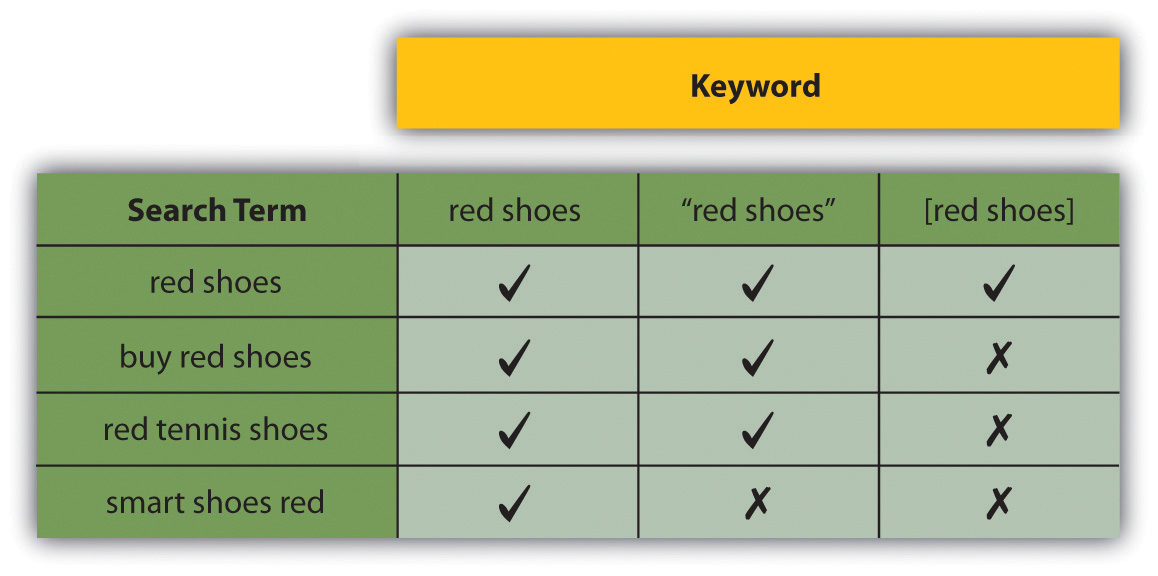
Negative match, denoted by using a dash in front of the keywords (-negative), means that your advertisement will not appear in searches using that word, no matter what other words are used.
Use the broad match example, and include a negative match:
- red shoes
- -tennis
Your advertisement would appear for the following:
- red shoes
- smart shoes red
Your advertisement would not appear for the following:
- red tennis shoes
Advertisers can assign as many keywords as they wish to an advertisement, but only one advertisement for each URL (uniform resource locator) will be shown. If two advertisers are bidding to show advertisements for the same domain, only one will be shown. Which advertisement will be shown is based on the bids being placed and on the quality of the advertisements.
Languages and Locations
You are able to target your campaigns, so you know that the trafficThis refers to the visitors that visit a Web site. you are getting is relevant to your product. This is known as geotargeting.
You can choose the language of the search engine and the location. For example, you might only want your advertisement to show to English searches in Asia, or to English searches in London. Targeting your advertisement means that you won’t pay for traffic you don’t want.
Bidding and Ranking
Advertisers need to determine the maximum they are willing to pay for a click on their advertisement, and they need to decide this for each keyword they enter for an advertisement. This bid is the maximum CPC (cost per click), or max CPC, that the advertiser is willing to pay for the click.
Note
A Vickrey auction is an auction where bidders do not know what bids others have placed. It is a sealed auction. The Vickrey-Clarke-Groves mechanism is the generalization of the Vickrey auction that holds that bidders will bid truthfully. In PPC advertising, this is not always the case. Bidders sometimes bid to push prices for their competition instead of to maximize their own revenue.
However, this will not necessarily be the CPC that the advertiser must pay for a click. Every time a search query is entered, the search engine runs an auction to determine the placement of the advertisements where advertisers have bid on that search term. This auction is known as a generalized second price (GSP)Auction type that search engines are modeled after. auction, which is a variation on the Vickrey auction.
In the GSP auction, each advertiser will pay the bid of the advertiser below him, plus a standard increment (typically $0.01), for a click on the advertisement.
Say three advertisers, A1, A2, and A3, bid $2.50, $3.00, and $2.35, respectively, on the same keyword. The search engine has set a minimum price of $2.05 on that same keyword. Figure 7.6 "Example of Advertisers Bidding on the Same Keyword" shows how the advertisements would be positioned and what they would each pay for a click.
Figure 7.6 Example of Advertisers Bidding on the Same Keyword
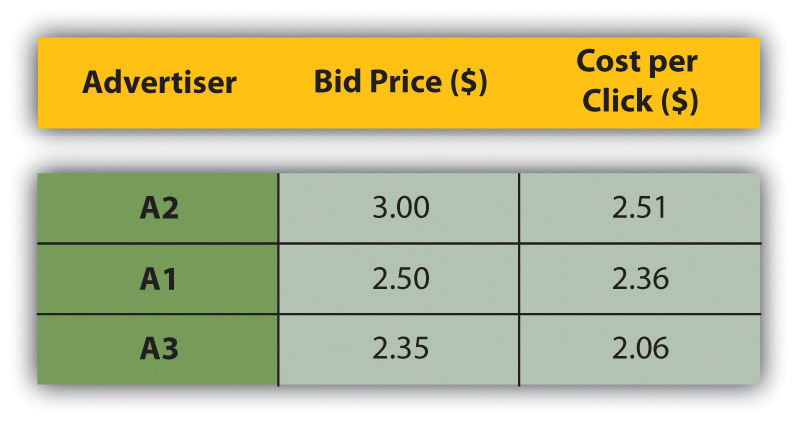
When it comes to rankingProcess by which search engines display Web sites so that the most relevant Web sites appear on the top. Search engine optimization is a technique by which high rankings may be obtained., of course, it’s not quite as simplistic as that. As well as the bid an advertiser places on a keyword, the search engine will take a number of other factors into account. In the case of Google AdWords, this is known as Quality ScoreGoogle’s basis for determining the minimum bids for keywords, based on relevancy and historical data..
The Quality Score is determined by the following, among other factors:
- The relevance of the keyword to the search term
- The relevance of the advertisement copy to the search term
- The relevance of the landing page to the search term
- The historic click-through rate (CTR)Clicks divided by impression percent. of that advertisement
Search engines look at factors such as relevancy to try to ensure that it is not just having deep pockets that can land advertisers the top spot. Search engines need to ensure that users find the advertisements relevant, otherwise they’ll be less likely to click on them—and no click means no revenue for the search engine.
Conversion Rates and Click-Through Rates
Figure 7.7 A Heat Map from Eyetools.com That Shows Where Users Look on a Search Engine Results Page (SERP)
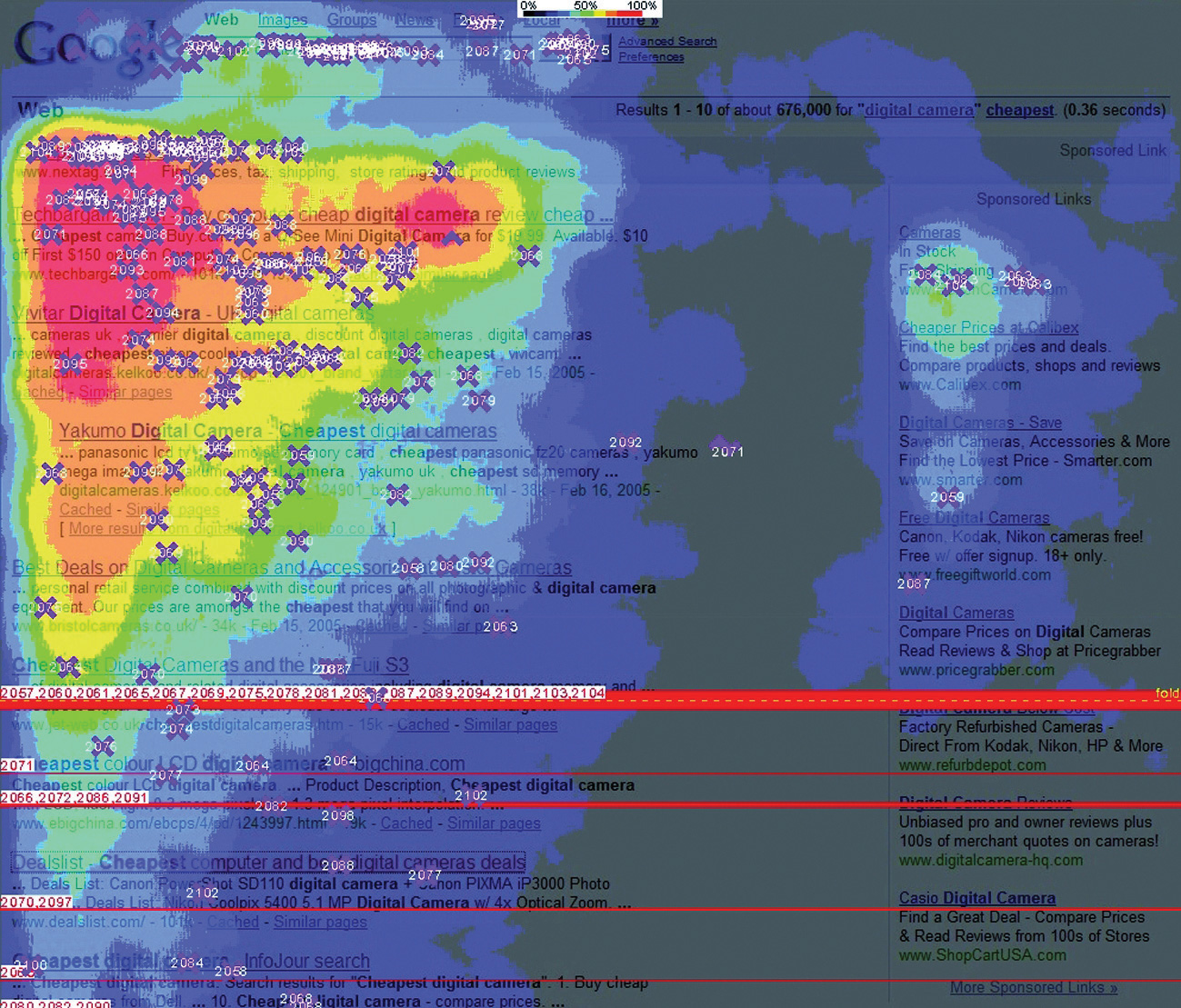
Source: Heatmap generated by Eyetools, Inc.
Studies repeatedly show that those advertisements nearer the top of the page (so the best ranked) attract the highest CTRs (click-through rates). They get the most clicks. And the clicks cost the advertisers more.
Looking at the heat map, you can see that getting in the blue box on Google will most likely generate even more clicks on an advertisement. You might think the more clicks the better, but is this necessarily the case?
Being in the top position means you will pay more per click. Many clicks at a higher price may use up your budget quickly. Also, many people click on the top advertisement believing it to be the top organic search result—often without reading the advertisement text.
Advertisers need to consider what a user does after clicking through to the advertiser’s Web site from the search engine. When planning a PPC campaign, it is therefore crucial to set up the goals of the campaign and make sure that these are being met. You can use your analytics package to set these up. With a goal set up, the advertiser can track how many of the users that click throughA click on a link that leads to another Web site. to the Web site follow through to that goal. This is called a conversion.
Goals can be any of the following:
- Buying a product
- Filling in a form
- Downloading a white paper
- Sending an inquiry
- Booking a flight
We know that the CTR of an advertisement is the percentage of clicks divided by impressionEach time the advertisement is shown..
The conversion rate of an advertisement is the percentage of conversions divided by click.
As the advertiser, you also need to know the value of each conversion. You need to know this so that you don’t pay too much for your clicks, and so that you bid to have the best CTR for maximum return on investment (ROI)The ratio of cost to profit (e.g., advertising spending as a percentage of the revenue that it generates)..
Figure 7.8 How to Adjust Bidding Strategies Based on Business Principles

Figure 7.8 "How to Adjust Bidding Strategies Based on Business Principles" shows how you might adjust bidding strategies based on business principles such as the following:
- Example A. Bid on a keyword with phrase match.
- Example B. Bid on the same keyword with phrase match, but bid for a higher position. The conversion rate of the Web site remains the same, but because of the higher CPC, the CPA (cost per action)Paid when a certain action is performed by a user. increases, although there are more conversions.
- Example C. Bid on the same keyword, but with broad match this time. Because the traffic is less targeted, the conversion rate on the Web site is lower. This means that the CPA increases again.
The campaign needs to be run according to business rules. A PPC campaign can aim for maximum conversions, but this is usually at a higher CPA.
Budgets
As well as deciding on your CPC bids for your keywords, you are able to determine the budgets for your campaign. You can set daily budgets, monthly budgets, or no budget. Once your budget is reached, your advertisements are paused, so you can be sure that you never overspend. If you are concerned about overspending, you can set a daily budget. However, this can mean that your advertisements do not run as often as you would wish them to.
The different advertising platforms offer advanced bidding options, all aimed at helping you to run your advertising campaign better. You can bid for placement on the search engine results page (SERP)The actual results returned to the user based on their search query., or you can bid based on how much you are willing to pay for a click. You are able to bid for advertisements during certain times of the day only, called scheduling.
Note
Scheduling allows the advertiser to show their advertisements only at certain times of the day. For example, an advertiser might want to time their advertisements to show at the usual time for lunch breaks.
Which Platform Should I Choose?
There is some theory that different platforms are better for different industries. For example, some believe that Yahoo! fares better than Google on travel advertising. However, this is subjective, and most large advertisers will run PPC campaigns on a number of platforms. As with most things in eMarketing, it is all about testing.
There are some small differences with each platform in terms of editorial policy, and each system has a different user interface. Google AdWords, perhaps the most well known, allows users to transact in the currency of their choice and also offers training programs and certifications.
Google AdWords also currently has the best geotargeting worldwide, although geotargeting is offered by both Microsoft adCenter and Yahoo! Search Marketing.
The Long Tail
Google has estimated that 50 percent of searches are unique. This means that the sum of unique searches is about the same as the sum of nonunique searches. Looking a little more closely at search terms will show a small number of high-volume searches, and then a large number of lower volume searches stretching out to those unique searches.
Figure 7.9
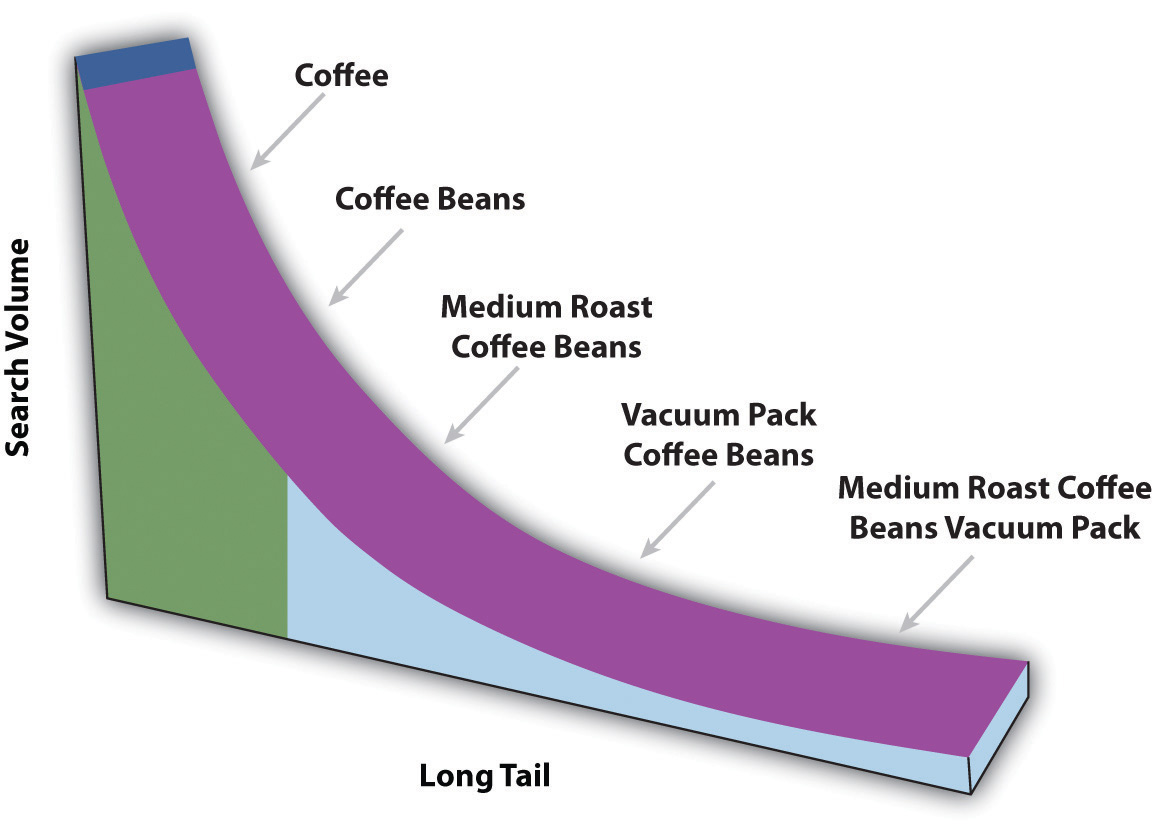
In the long tail, the sum of the low-volume searches matches the high-volume searches.
This is sometimes referred to as the long tail of search. Figuring out those low-volume, niche search terms can do wonders for a PPC campaign. Generally there is not much competition for those search terms, and the search term itself is very targeted.
AdWords offers an AdWords Starter Edition—sign up for an account to see how it works! You can sign up from http://adwords.google.com. Just choose “Starter edition” after you click to sign up.
Key Takeaways
- Advertisers can define keywords for which their ad should appear.
-
Google uses the following match types:
- Broad
- Phrase
- Exact
- Negative
- Advertisers can assign as many keywords as they wish to an ad, but only one ad for each URL (uniform resource locator) can be shown.
- Advertisers can target by location and language for added relevancy.
- Advertisers can determine the maximum they are willing to pay for a click on their ad. This is known as bidding, and it determines ranking.
- Every time a search query is entered, the search engine runs an auction to determine the placement of the advertisements where advertisers have bid on that search term.
-
The Quality Score is determined by four main factors:
- The relevance of the keyword to the search term
- The relevance of the advertisement copy to the search term
- The relevance of the landing page to the search term
- The historic CTR (click-through rate) of that advertisement
- There are many things in a PPC (pay-per-click) campaign that can affect conversion rates and CTRs. An advertiser needs to evaluate goals to see what is best.
- Budgets are based on CPC (cost-per-click) bids. Advertisers have flexibility in how their budgets run.
- Testing is essential in determining what search platform is best.
- It is important to consider long-tail keywords in a campaign.
Exercises
- What is the importance of long-tail keywords in a PPC (pay-per-click) campaign?
- Following the examples above, give examples of when you’d use exact match and negative match. When is it OK to use broad match?




